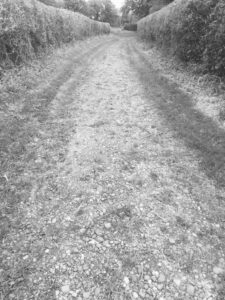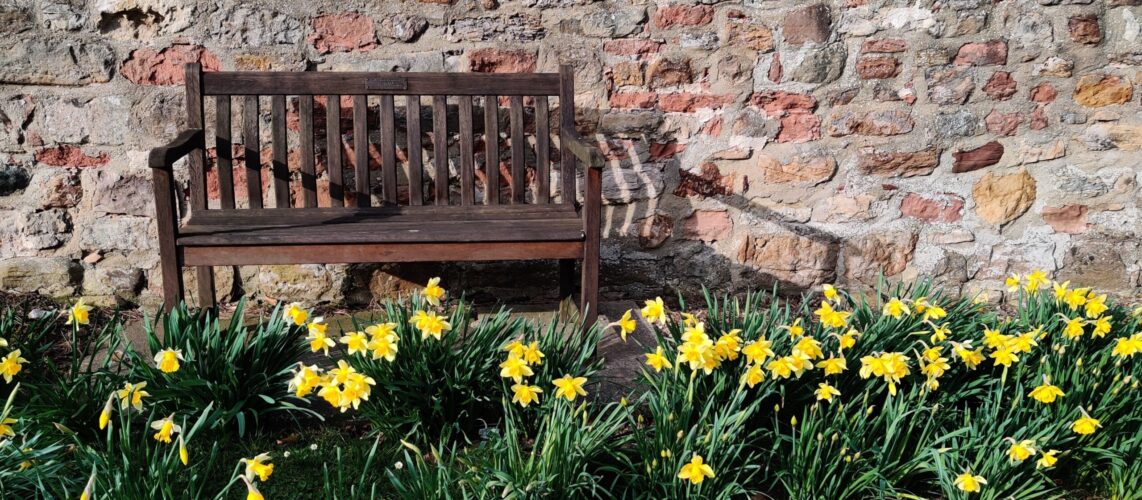ARCHAEOLOGY
A geophysical survey was undertaken by Tees Archaeology under the direction of Robin Daniels. The results are in an unpublished report (2019) entitled ‘The Village of Eryholme, North Yorkshire, its earthworks, history and geophysical survey’ and it is full of interesting information, particularly on the layout of medieval Eryholme.
It is available in digital form via the Tees Archaeology Unpublished Report Series and can be found by searching the data base and library – click here
THE GREAT NORTH ROAD/THE KING’S WAY/HIGH STREET
As mentioned, the route across the river Tees between North Yorkshire and County Durham was a major highway and one of three main crossing points from York to Durham (the others being at Croft and Pountees). Indeed, until the establishment of the toll road to Darlington in the eighteenth century, it may be described as the Great North Road. The river could be crossed by ford and ferry and it is likely to have been in use before 1066, leading to the (probable) legend that the body of St Cuthbert was carried across in 995 on its way to its final resting place in Durham.
The small settlement of Eryholme must have witnessed a great deal of traffic, including Kings and noblemen, diplomats and armies, both English and Scottish. It was reported that there was ‘usually a boat ready for horses and all’ and deposition evidence in 1360 describes several merchants and artisans with their goods and carts going past the village on their way to and from the Darlington Fair. The inhabitants may well have profited from this traffic although the large entourages of kings exercising their right to supply themselves wherever they went may not have been so welcome. However they would have seen, for example, Henry IV in 1448, ‘right merry on his pilgrimage’ on his way to Durham, as well as several bishops of Durham going to and from Westminster, including a future Pope (Pius II) in 1436. One very important traveller, whose journey is documented, was Princess Margaret, the sister of Henry VIII, who in 1503 was journeying to Edinburgh to marry James IV of Scotland. With her huge entourage, it must have been a spectacular sight. From Northallerton she was accompanied by the sheriff of Yorkshire, Sir James Stangways, as well as the local gentry and was met, perhaps in the middle of the river, by Sir Ralph Bowes and a company of 40 Durham men on horseback. She then stayed the night at Neasham Priory.
In the next century the villagers would have seen another spectacular event when the new bishop of Durham, John Cosin, and his cavalcade passed through on his way for his ceremonial entry into the Palatinate. It was noted by a member of the entourage that, in August 1661, the high sheriff, the whole of the gentry and the militia-horse of Durham were present ()one thousand horse in all, all of whom moved into the middle of the river to meet the bishop. Here ‘the usual ceremony’ was performed. The bishop himself recalled that on his ‘first entry through the river of Tease…. there was scarce any water to be seen ‘for the multitude of men and horse that filled it’. This was the well-known presentation of the falchion, a ceremony that still takes place today when there is a new bishop of Durham. It now, however, occurs on the middle of Croft Bridge between the bishop and the Mayor of Darlington, with considerable less pomp and ceremony.
Eryholme did, however, have the obligation to maintain the stretch of the ‘king’s highway’ from Entercommon to the ford and in April 1605, for example, the inhabitants were presented to the justices of the peace for not repairing the ‘high street and king’s way’ at ‘Break-howse’. John Idson left 10 shillings in his will in 1638 for its repair and was probably not the only one as it was considered a communal duty and act of philanthropy. It certainly seemed to be regarded as the preferred main route north and south in the seventeenth century and is depicted in the first set of English road maps produced by John Ogilby in 1675. He gave directions for travellers on the Great North Road, though failed to mention the risk of highwaymen who after 1660 lurked between Hurworth, Neasham and Darlington. One of the most notorious was a man named Tomlinson who murdered Mary Allinson of Eryholme in Oxney field, as noted in the parish register, and ‘barbarously’ slaughtered’ John Neesom in 1663. The travellers on this route, avoiding potholes, would have gone through countryside not dissimilar from today, passing settlements which still exist.
Other less fortunate travellers were vagrants. It was the law in the eighteenth century that the homeless destitute should be returned to their place of birth and in 1795, for example, more than 500 passed through Eryholme, being on the northern border of the designated route north and south. This was probably the peak but traffic was very heavy the decades before and after 1800 when poverty and vagrancy were widespread throughout the country. Passes were developed and contractors employed to convey this wretched cargo of mainly women and children, usually being moved north, together with a large number of Scots who had been expelled from London. The numbers gradually declined and stopped altogether with the passing of the Poor Law Amendment Act in 1834.
Until the second half of the eighteenth century, the highway continued to be the main route connecting York and Durham though it was not always passable and lives were lost in sudden flash floods. John Whitfield of Birkby, for example, ‘who was drowned’, was buried by the curate. On the other hand, the legendary short-horn cattle breeder, John Maynard (1744-1826), at the age of 70 reputedly rode his hack, ‘Black Tom’ to and from Newcastle in one day ( a journey of 80 miles). Arriving back in Neasham he found the Tees in flood and rode his horse into the high ford, which swam across and landed at the low ford 500 yards downstream. (This was probably the great flood of 1815). At other times droughts made it very difficult for the ferry to operate as did severe frosts which froze the river
Traffic began to decrease with the establishment of the Northallerton to Darlington Turnpike in 1745 and the tollgate at Entercommon. The consequent improved road surface and availability of stage coaches meant that the crossing of the Tees became concentrated at Croft Bridge and the village eventually became bypassed. However, the ford continued to be used by locals and it was noted in 1856 that the river could still be crossed ‘by a ferry or by a broad and safe ford’, though the ferry, kept in a boathouse next to the Fox and Hounds in Neasham, was discontinued twenty years later. Nevertheless, what was once was a very important national road was still maintained, although the access to the ford, as well as the ford itself, was not. Even so, it is still used by local farmers on tractors and several residents recall wading across to the pub when the river was low. Rather different from the pomp and ceremony of events centuries ago.

The King’s Highway as it is today.
LIST OF OCCUPIERS AND TENANTS, 1539-1911
We hope this will be of use to family historians. Further information is available on several of these inhabitants and can be obtained by contacting Tony Pollard via the Website contact page.
Villagers named in surveys, tax records, private deeds and testamony evidence, 1499-1696
Freeholders 1499, at enclosure with probably property
William Johnson Toune End’, ‘Fogey Close’, garths and orchard
Thomas Winspear Low Holmes (now The Holmes)
William Wormeley The Holmes (now Low Holmes)
John Wrightson Gosling Ings’, ‘High Garth’, ‘Fatting Fields’
1539 muster
William Carter
Simon Huchinson
Richard Johnson
Thomas Johnson
Thomas Newson
John Sadler
Nicholas Spark
Richard Winspear
Robert Wormeley
1543-5 subsidy
Miles Barnes
Roland Blakey
William Blakey
Richard Breer
Robert Burnett
Edward ‘Doltert’
William Fletcher
James Fogythwayt
William Freer
Thomas Hodstans
Anthony Husband
Richard Johnson
Thomas Johnson
Thomas Nesham
John Sadler
Thomas Simpson
Nicholas Spark
Thomas Spence
1550 – Thomas Markenfield, lord of the manor, mentioned in his will
Richard Breer
Thomas Burnett Hill House (now Eryholme Grange)
Michael Spence
1570 – Tenants listed in a survey of the Markenfield estate
George Blakey
Will Blakey
Ninian Breer
Elizabeth Burnett
John Burnett
James Freer
Ralph Johnson
Thomas Neesom
William Neesom
Edward Pulham
Thomas Winspear
Will Wormeley,
Richard Wrightson
Residents implicated in the Rising of the Northern Earls in 1569
Marmaduke Batmanson
George Blakey
John Blakey
William Blakey
Henry Branson
Ninian Breer
James Freer
John Markenfield
Thomas Neesom
Matthew Saddler
RIchard Wetherell
William Wormeley
Thomas Wrightson
William Wormeley
John Wrightson
Thomas Wrightson
John Wynspear
1624/28
WIlliam Batmanson
Stephen Blakey
William Blakey
John Burnett
William Burnett
Thomas Foxe
Richard Heighington
John Hickson
Reginald Neesom/Neasom
William Neesom
Christopher Richardson
Robert Winspear
1673
John Bayles
Marin Batmanson
George Blakey
Christopher Bland
Ra (chel?) Bland
Christopher Binkes
James Bowman
George Burnett
Richard Burnett
Henry Calverley
William Carter
Matthew Cooper
Luke Darnton
Oswald Gillery
Thomas Neesom/Neasom
William (?) Neesom/Neasom
Bernard ‘Rumler’
John Russell
John Singleton
Edward Stainforth
Stephen Stainforth
ChristopherTaylor
George Wind
Dorothy Winspear
Joseph Wood
Elizabeth Wright
James Wrightson
1696
Ellen Bainbridge
George Burnett
Elizabeth Carter
George Darnston
George Dobson
Anne Farnaby
Anne Franke
Oswald Gillery
George Girswood
William Golsburgh
Robert Green
Robert Harrison
Anthony Hayton
Anthony Hodgson
Barbara Johnson
Jane Johnson
John Langstaffe
Jane Nesham
William Nesham
Christopher Pinkney
John Russell
John Sadler
Bennet Sherard (absentee)
Ellen Singleton
Stephen Stainforth
Ann Swainston
John Thomason
Margery Wilson
To be continued
